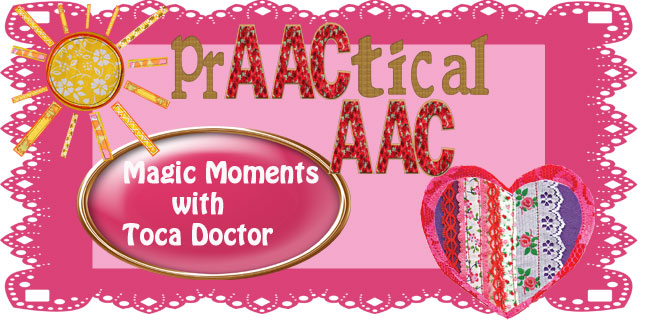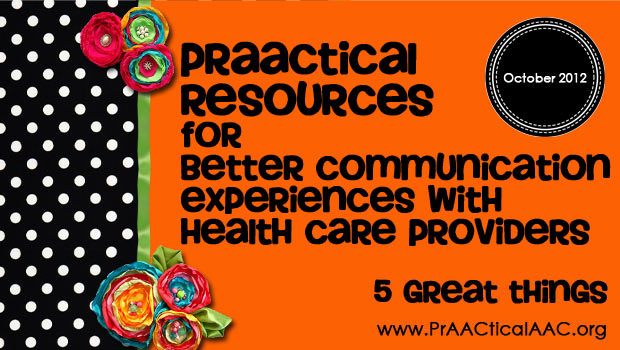 Magic Moments: AAC Intervention with Apps You Love-
Magic Moments: AAC Intervention with Apps You Love- Toca Boca Doctor
“An apple a day keeps the doctor away”… If it were only that simple. But it is not that easy and since we are right in the middle of cold and flu season, it reminds us about teaching AAC users to let us know when they are not feeling well. The more we can find ways to make the concepts of pain, injury, and distress more concrete and specific, the easier it is to learn. Telling others about your own discomfort is an important self-advocacy and self-determination skill.
—-
On a more PrAACtical note, telling about your symptoms and location of distress will help you get the proper treatment for your problem. Venting or complaining about your distress will get you good stuff –like sympathy, flexibility, and even extra reinforcement (and who doesn’t want more reinforcement). When you don’t use conventional communication to ‘tell’ or’ vent’ about your own distress, there will definitely be some unconventional ‘telling’. In the distress arena that usually means challenging behavior, less motivation, less tolerance for work, people, and/or activities. This becomes a problem because if others do not understand the ‘unconventional’ message they may assume non-compliance and that does not lead to the good stuff.
 Toca Boca Doctor app has a series of mini-games that help users learn about identifying and telling about areas of potential distress in the body, how to fix it and what it looks like when it works well. There are many language concepts that go well with playing Toca Boca Doctor. Ideas that we have used include cause and effect language. Causal relationships can be modeled about an injury, how it is treated, and what the result would be. It is great because with modeling you can teach ‘because’ and ‘so’ without asking the why’ question (typical language users often talk about causality without being asked a question). You can also model concepts such as ‘help’ or ‘help for my ‘LEG’. This gives many opportunities for planned redundancy with variation.
Toca Boca Doctor app has a series of mini-games that help users learn about identifying and telling about areas of potential distress in the body, how to fix it and what it looks like when it works well. There are many language concepts that go well with playing Toca Boca Doctor. Ideas that we have used include cause and effect language. Causal relationships can be modeled about an injury, how it is treated, and what the result would be. It is great because with modeling you can teach ‘because’ and ‘so’ without asking the why’ question (typical language users often talk about causality without being asked a question). You can also model concepts such as ‘help’ or ‘help for my ‘LEG’. This gives many opportunities for planned redundancy with variation.—
Symbolic play and joint action routines can easily be facilitated using this app. You can take turns being the doctor or patient here and practice the language that goes with both roles (i.e., ‘examine’ vs ‘help’, ‘you will get a cast’ ’ vs ‘can I swim with a cast?’. You can also practice the language that goes with symbolic play (‘pretend’, ‘not real’, ‘play’, etc). This type of play and routines also can serve as a variation of the social story intervention strategy because there are options to model different outcomes for what both roles might say in different scenarios. This will help with practice with being ready in advance for what might happen at a doctor’s office or emergency room. The various language concepts will have also been located (on an AAC device or communication boards and USED many times (planned redundancy with variation) in the role-playing games.
—

We think this app also lends itself well to the teaching strategy of ‘Plan Do Review’. You can PLAN the trip to the doctor’s office (playing the app) by making a list of ‘what is wrong’, ‘what you will say to the doctor’, talk about becoming a career as a doctor or just play doctor with pretend props. After you play or DO the app, you can create ‘doctor notes’, you can ‘tell or write about what happened’, or you can play ‘doctor’ with toys and props. As we have heard Sean Sweeny, (a.k.a. Speech Techie) say “app play is just one part of the learning experience”. The possibilities are limitless…..




